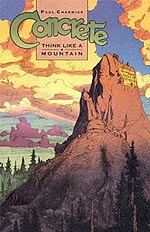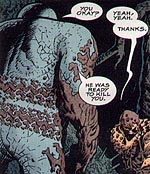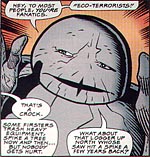>> The Friday Review: The Tale Of One Bad Rat
>> The Friday Review: Cathedral Child
More...

 Writer/Artist: Paul Chadwick
Writer/Artist: Paul Chadwick
Colouring: Chris Chalenor
Letterer: Bill Spicer
Collecting CONCRETE: THINK LIKE A MOUNTAIN #1-6
Price: $17.95
Publisher: Dark Horse Comics
ISBN: 1-56971-176-3
On the face of it, the basic premise for CONCRETE seems neither very original nor even particularly interesting. "Enigmatic aliens transplant man's brain into indestructible body for no apparent reason" is the stuff of pulp SF. The idea of a tortured individual encased in a rocky body, and thus unable to quite fit in with society, also bears more than a passing resemblance to The Thing from Marvel's FANTASTIC FOUR superhero saga.
But therein lies the difference. Concrete is never portrayed as anything remotely resembling a superhero. Ron Lithgow's world is not one that's full of morally simplistic men-in-tights, and after his transformation there's no superclub orbiting the world in a satellite looking to recruit him.
On the contrary, Concrete has a likeable "everyman" quality about him as he stumbles (both literally and metaphorically) through life looking for his place in the world. Needing neither rest nor shelter, feeding on rocks and unable to procreate, Concrete is removed from most of the normal human desires. Faced with this existential dilemma, Concrete must nevertheless still determine for himself the answer to the age-old question of "what am I doing here?" that troubles many of us.
Given the very real prospect of living forever, though, Concrete must take the longer view. He must think like the titular mountain that he resembles (a phrase coined by noted environmentalist Aldo Leopold).
In previous stories, Concrete has been using his peculiar gifts to make a living (working in the movies during FRAGILE CREATURE for instance) and gain otherwise impossible new experiences (such as climbing the Himalayas). Over these latter stories, there's been real growth in the character as he develops an awareness of the world around him and a strong ecological conscience.
All of which sets the stage nicely for THINK LIKE A MOUNTAIN, where he becomes involved with a cell of the controversial "Earth First!" ecological activists. Being a law-abiding type who avoids confrontation whenever possible, Concrete is initially reluctant to become actively involved with the group. But nevertheless he is persuaded to observe and chronicle their efforts to save a particular Old Growth Forest in Washington State from being wiped out by logging.
 During a sequence of experiences - his exposure to some of which is deliberately engineered by the EF Crew - Concrete begins to doubt decision to stand on the fringe of a struggle in which he passionately believes. Especially when his unique nature could be so effective in the group's "monkeywrenching" sabotage, and would draw attention to the group's efforts. Played out against the backdrop of the EF's efforts to save the ancient "Hidden Valley" forest is Concrete's own struggle with his conscience, as he tries to determine exactly what he's willing to do in support of his beliefs.
During a sequence of experiences - his exposure to some of which is deliberately engineered by the EF Crew - Concrete begins to doubt decision to stand on the fringe of a struggle in which he passionately believes. Especially when his unique nature could be so effective in the group's "monkeywrenching" sabotage, and would draw attention to the group's efforts. Played out against the backdrop of the EF's efforts to save the ancient "Hidden Valley" forest is Concrete's own struggle with his conscience, as he tries to determine exactly what he's willing to do in support of his beliefs.
Although creator-owned, CONCRETE has always been associated with Dark Horse Comics - indeed the first CONCRETE story ('Lifestyles Of The Rich And Famous') appeared in the launch issue of DARK HORSE PRESENTS in 1986. With 1994's KILLER SMILE, CONCRETE became one of the founding titles in Dark Horse's Legend imprint, created to showcase the work of such heavy hitters as Frank Miller (SIN CITY) and Mike Mignola (HELLBOY). This, in turn, begat the current Maverick imprint, which is dedicated solely to creator-owned works from Miller et al.
CONCRETE had already been running for a number of years at the inception of Legend, first as an ongoing series (since collected as THE COMPLETE CONCRETE), then as a series of mini-series, each featuring a discrete story arc. This more leisurely pace seemed to suit Chadwick better, and by the time Legend launched, the first CONCRETE mini in the new format (FRAGILE CREATURE) had already won him an Eisner award for best mini-series of 1991.
Chadwick's art is full of small details and subtle touches. The door to Concrete's house has dents in the frame, gently reinforcing the idea that Ron has still to totally come to terms with the size and power of his alien body. The fact that Concrete's vision is considerably enhanced is mentioned a few times in the text, but the point is never overstressed through any gratuitous and overly dramatic scenes involving this "Concrete-vision". Rather, we see Concrete contemplating his situation in the open air, with the night sky above him ablaze with multi-coloured pyrotechnics as opposed to the pinpricks of starlight visible to the others.
A story with the majesty of the natural world as a central theme must also work on a larger scale, and here too Chadwick delivers. Particularly worth noting is the finely judged use of two-page spreads. These range from a breathtaking aerial vista of several acres of tree stumps - each marked with the lifespan of that particular felled tree (some as long as 500 years) painted on by an EF activist - to the dramatic sight of an EF crew running into the night as monkeywrenched logging machinery burns behind them.
 There're also the imaginative depictions of Ron's frequent inner monologues, a particularly innovative one being when he imagines humanity as a single giant person consuming cattle by the trainload and grain by the tanker-full. The full-page image of this titan cutting a swathe through the landscape with a chainsaw made of factories and aircraft parts (to represent the effects of new technology) is extremely striking and affecting.
There're also the imaginative depictions of Ron's frequent inner monologues, a particularly innovative one being when he imagines humanity as a single giant person consuming cattle by the trainload and grain by the tanker-full. The full-page image of this titan cutting a swathe through the landscape with a chainsaw made of factories and aircraft parts (to represent the effects of new technology) is extremely striking and affecting.
Chadwick's scripting is also effective, imparting a wealth of information on various environmental abuses (from the logging that features in this story, to the abandoned "ghost" driftnets snaring unwary marine life) and attempting to present the full range of viewpoints from across the spectrum of the ecological debate. For the most part, Chadwick integrates these viewpoints fairly seamlessly into the narrative, using the EF members' education of Concrete to provide the reader both with examples of environmental damage and with an insight into the different degrees of extremism, though few of the activists are presented as well-rounded characters.
With Concrete cast in a kind of devil's advocate role as he tries to avoid conflict with authority, Chadwick is also able to present viewpoints that contrast with those of the EF. While Chadwick's scripting doesn't have quite the same fluidity of his sumptuous artwork, these debates between the characters seldom feel like anything less than organic parts of the story. Very occasionally the dialogue does become a little stilted as the narrative reaches one of the 'big points' that Chadwick has chosen to make, but such instances are thankfully rare.
In interviews at the time of release, Chadwick identified himself as being in a similar position to that which his creation takes up, being sympathetic to the EF cause, but concerned about some of their tactics. Given this, it's creditable that the loggers aren't demonised, but depicted as fallible human beings in the same way as the EF members.
CONCRETE has always been a fresh and original voice in the medium, opting for the articulate telling of intelligent and introspective tales. Of which THINK LIKE A MOUNTAIN is the most thoughtful and thought-provoking, though it never loses sight of the fact that it's also meant to entertain.
Paul Chadwick avoids the standard pitfalls inherent in using a superhuman protagonist, inverting the normal stereotype by having Concrete's alien body as a hindrance to be coped with rather than a vehicle for a simplistic adolescent power fantasy. The central conflict faced by the main character is one of conscience, and one that translates to anyone in the same position: how far will a person go in support of their beliefs?

This article is Ideological Freeware. The author grants permission for its reproduction and redistribution by private individuals on condition that the author and source of the article are clearly shown, no charge is made, and the whole article is reproduced intact, including this notice.


